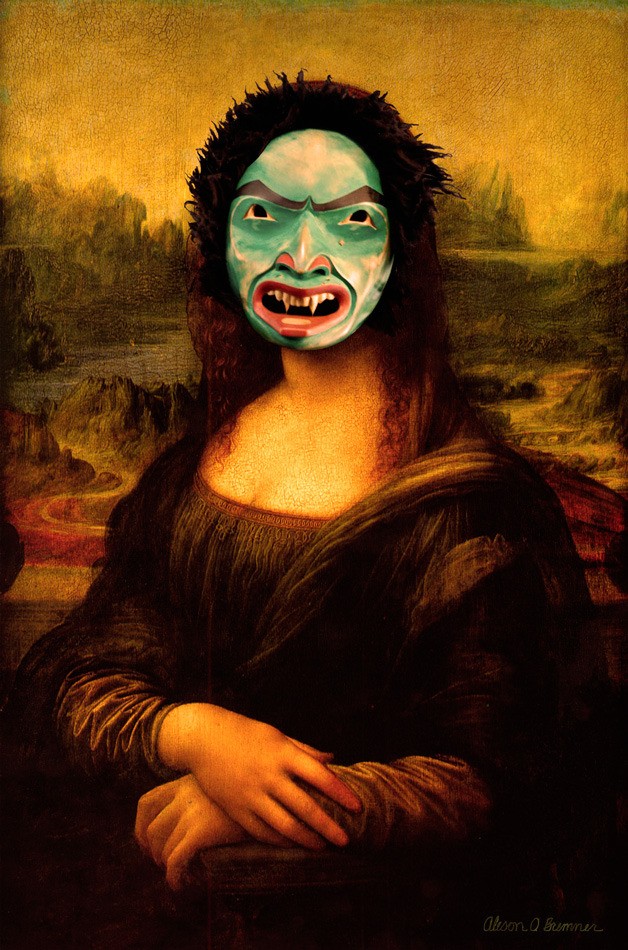Big Girl has retired.
Her 35mm arms were dismantled by BIMA’s installation crew on Monday.
Goodbye, reject sunglasses and castoff hot tub covers; may your plastic poison not spoil the ocean forever.
It’s time for new pieces.
This Saturday, six new shows arrive at the island art museum, along with a rotating bill in the Orientation Gallery.
First up is Kathleen Alcalá, in the room adjacent to the lobby. For two weeks, text from “Deepest Roots,” her fresh memoir on food sustainability, will set off images by Joel Sackett.
On Nov. 1, the skeletons are at the altar for Dia de Los Muertos. The marigold-studded Mexican celebration returns for its third ofrenda (offering).
Last but not least, the museum honors artists in the making; education director Kristin Tollefson partners with island schools to spotlight student projects, on display through the first week in February.
The largest exhibition in the building is “Native Hands,” featuring indigenous art across the Salish Sea. BIMA executive director Greg Robinson consulted with guest curators Miranda Belarde-Lewis, Janet Smoak (Suquamish Museum) and Angela Flemming (Suquamish Foundation) for months before settling on the theme.
“We were thinking about ‘connecting waters’ because there’s quite a tradition of salmon culture with the Columbia River; we thought we could go up through, tracking the Columbia River, and then we realized we were biting off more than we could chew,” Robinson said.
Instead, the group cast their net tighter, limiting their scope to the Salish Sea and collecting nearly 100 works from 30 local artists.
“Since we opened, three years ago, we’ve wanted to develop more formal partnerships with the Suquamish Museum,” Robinson added.
Pieces have been borrowed from Clearwater Casino, the Stonington Gallery in Pioneer Square and the Steinbrueck Native Gallery near Pike Place.
“We wanted to learn more from Native Americans about what it means to be Native American today,” Robinson said. “We’re largely dealing with people who are living urban lives. I’m curious how someone can be fully apart of contemporary urban life and yet still hold on to that legacy.”
Gail Tremblay, a professor at Evergreen State College, combines old and new, weaving baskets out of motion-picture film strips, which often serve to critique the media’s depiction of Native Americans. “She wants to take things that are stereotypical or inaccurate and take them out of our collective libraries, the school libraries and public libraries, and remove that information from our consciousness,” Robinson explained.
Alison Bremner, a Tlingit artist who used to live in Suquamish, copies famous paintings from the Western canon, like “Mona Lisa” or “The Girl with the Pearl Earring,” and superimposes Native American masks onto them. “‘Mona Lisa Smile’ represents the exclusion of Northwest Coast art from the canon of ‘great art’ in mainstream art history,” she said. “It also speaks to the male gaze present in many famous paintings of women.”
Other artists featured in the exhibit include Larry Ahvakana, David Boxley, Rande Cook, George David, John Hoover, Marvin Oliver, Betty Pasco, Sean Peterson, Susan Point, Lisa Telford and Preston Singletary.
Alan Newburg, a Bremerton wood sculptor, will have his own exhibition (“Abstractions in Wood”) in the Lovelace Gallery, as will Patty Rogers (“We Keep It Inside Us”), in the Bistro Gallery.
Indianola artist Annette Fourbears, who has one piece in the Native Hands exhibit, also has her own show called “Weaving the Dream.” Using a Paiute beading technique, she adorns delicate pine-needle baskets with thousands of beads. She’s part Lenni Lanape (Delaware), part Shawnee, Cherokee and European, but as a member of the Northwest Native Basketweavers Guild, she has permission to weave in other traditions.
Catherine Alice Michaelis works with letterpress, pressure printing and other techniques to make prints and artist’s books. Her latest offering, “Sola: A Mythical Story About a Real Girl” will be on display in the Mesa Gallery as part of “Imprinted & Unbound.” As an added bonus, you can catch her appearance on the PBS show “Craft in America” several months early. The episode, titled “Nature,” also features “Native Hands” glass artist Preston Singletary. Tickets to the Oct. 23 premiere, at which both artists will be present along with “Craft in America” executive director Carol Sauvion, are $50. They can be purchased at www.craftinamerica.bpt.me, and include drinks and hors d’oeuvre.
The book arts room gets an update, too, with “Chapter 9: Local Heroes,” featuring book artists of Washington state. “Cynthia Sears describes artist’s books as the Trojan horse of the art world,” Robinson said.
“In a painting or a print, you may not understanding something at a glance, but you can for the most part visually digest it all in one blow. Whereas an artist’s book is something you have to manipulate; you have to open it up, unfold the pages. It reveals itself slowly.”
Sears’ delicate collection is safe behind glass cases and tables with vitrines, but two days a week, the museum invites patrons to spend time with staff member Amy Goldthwaite, who, donning gloves, can flip through pages by request.
The Bainbridge Island Museum of Art’s fall/winter exhibition debuts Saturday, Oct. 15, from 2 to 5 p.m.



